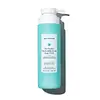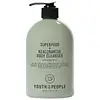What's inside
What's inside
 Key Ingredients
Key Ingredients

 Benefits
Benefits

 Concerns
Concerns

 Ingredients Side-by-side
Ingredients Side-by-side

Water
Skin ConditioningCocamidopropyl Hydroxysultaine
CleansingSodium Cocoyl Isethionate
CleansingSodium Cocoyl Taurate
CleansingNiacinamide
SmoothingGlycerin
HumectantSodium Chloride
MaskingGlycol Distearate
EmollientCoconut Acid
CleansingSodium Isethionate
CleansingPCA Glyceryl Oleate
EmollientTetrasodium Glutamate Diacetate
Xylitol
HumectantEthylhexylglycerin
Skin ConditioningSodium Phosphate
BufferingSodium Hydroxide
BufferingPhenoxyethanol
PreservativeWater, Cocamidopropyl Hydroxysultaine, Sodium Cocoyl Isethionate, Sodium Cocoyl Taurate, Niacinamide, Glycerin, Sodium Chloride, Glycol Distearate, Coconut Acid, Sodium Isethionate, PCA Glyceryl Oleate, Tetrasodium Glutamate Diacetate, Xylitol, Ethylhexylglycerin, Sodium Phosphate, Sodium Hydroxide, Phenoxyethanol
Water
Skin ConditioningCocamidopropyl Hydroxysultaine
CleansingSodium Cocoyl Isethionate
CleansingSodium Lauroyl Sarcosinate
CleansingGlycerin
HumectantSodium Chloride
MaskingBetaine
HumectantNiacinamide
SmoothingBrassica Oleracea Acephala Leaf Extract
HumectantCamellia Sinensis Leaf Extract
AntimicrobialChamomilla Recutita Flower Extract
MaskingMedicago Sativa Extract
TonicSpinacia Oleracea
Skin ConditioningAscorbyl Glucoside
AntioxidantHydroxyacetophenone
AntioxidantSodium Hydroxide
BufferingTrisodium Ethylenediamine Disuccinate
Citric Acid
BufferingPanthenol
Skin ConditioningCaprylyl Glycol
EmollientCoconut Acid
CleansingPolyglyceryl-4 Caprate
EmulsifyingQuillaja Saponaria Wood Extract
Skin ConditioningSodium Isethionate
CleansingHexyl Cinnamal
PerfumingLimonene
PerfumingLinalool
PerfumingPhenoxyethanol
PreservativeSodium Benzoate
MaskingParfum
MaskingWater, Cocamidopropyl Hydroxysultaine, Sodium Cocoyl Isethionate, Sodium Lauroyl Sarcosinate, Glycerin, Sodium Chloride, Betaine, Niacinamide, Brassica Oleracea Acephala Leaf Extract, Camellia Sinensis Leaf Extract, Chamomilla Recutita Flower Extract, Medicago Sativa Extract, Spinacia Oleracea, Ascorbyl Glucoside, Hydroxyacetophenone, Sodium Hydroxide, Trisodium Ethylenediamine Disuccinate, Citric Acid, Panthenol, Caprylyl Glycol, Coconut Acid, Polyglyceryl-4 Caprate, Quillaja Saponaria Wood Extract, Sodium Isethionate, Hexyl Cinnamal, Limonene, Linalool, Phenoxyethanol, Sodium Benzoate, Parfum
 Reviews
Reviews

Ingredients Explained
These ingredients are found in both products.
Ingredients higher up in an ingredient list are typically present in a larger amount.
Cocamidopropyl Hydroxysultaine is a synthetic cleansing agent, though it is derived from coconut oil.
It is used to enhance the texture of products by boosting lather and thickening the texture. As a cleanser, Cocamidopropyl Hydroxysultaine is mild.
Coconut Acid isn't fungal acne safe.
Glycerin is already naturally found in your skin. It helps moisturize and protect your skin.
A study from 2016 found glycerin to be more effective as a humectant than AHAs and hyaluronic acid.
As a humectant, it helps the skin stay hydrated by pulling moisture to your skin. The low molecular weight of glycerin allows it to pull moisture into the deeper layers of your skin.
Hydrated skin improves your skin barrier; Your skin barrier helps protect against irritants and bacteria.
Glycerin has also been found to have antimicrobial and antiviral properties. Due to these properties, glycerin is often used in wound and burn treatments.
In cosmetics, glycerin is usually derived from plants such as soybean or palm. However, it can also be sourced from animals, such as tallow or animal fat.
This ingredient is organic, colorless, odorless, and non-toxic.
Glycerin is the name for this ingredient in American English. British English uses Glycerol/Glycerine.
Learn more about GlycerinNiacinamide is a multitasking form of vitamin B3 that strengthens the skin barrier, reduces pores and dark spots, regulates oil, and improves signs of aging.
And the best part? It's gentle and well-tolerated by most skin types, including sensitive and reactive skin.
You might have heard of "niacin flush", or the reddening of skin that causes itchiness. Niacinamide has not been found to cause this.
In very rare cases, some individuals may not be able to tolerate niacinamide at all or experience an allergic reaction to it.
If you are experiencing flaking, irritation, and dryness with this ingredient, be sure to double check all your products as this ingredient can be found in all categories of skincare.
When incorporating niacinamide into your routine, look out for concentration amounts. Typically, 5% niacinamide provides benefits such as fading dark spots. However, if you have sensitive skin, it is better to begin with a smaller concentration.
When you apply niacinamide to your skin, your body converts it into nicotinamide adenine dinucleotide (NAD). NAD is an essential coenzyme that is already found in your cells as "fuel" and powers countless biological processes.
In your skin, NAD helps repair cell damage, produce new healthy cells, support collagen production, strengthen the skin barrier, and fight environmental stressors (like UV and pollution).
Our natural NAD levels start to decline with age, leading to slower skin repair, visible aging, and a weaker skin barrier. By providing your skin niacinamide, you're recharging your skin's NAD levels. This leads to stronger, healthier, and younger looking skin.
Another name for vitamin B3 is nicotinamide. This vitamin is water-soluble and our bodies don't store it. We obtain Vitamin B3 from either food or skincare. Meat, fish, wheat, yeast, and leafy greens contain vitamin B3.
The type of niacinamide used in skincare is synthetically created.
Learn more about NiacinamidePhenoxyethanol is a preservative that has germicide, antimicrobial, and aromatic properties. Studies show that phenoxyethanol can prevent microbial growth. By itself, it has a scent that is similar to that of a rose.
It's often used in formulations along with Caprylyl Glycol to preserve the shelf life of products.
Chances are, you eat sodium chloride every day. Sodium Chloride is also known as table salt.
This ingredient has many purposes in skincare: thickener, emulsifier, and exfoliator.
You'll most likely find this ingredient in cleansers where it is used to create a gel-like texture. As an emulsifier, it also prevents ingredients from separating.
There is much debate on whether this ingredient is comedogenic. The short answer - comedogenic ratings don't tell the whole story. Learn more about comegodenic ratings here.
The concensus about this ingredient causing acne seems to be divided. Research is needed to understand if this ingredient does cause acne.
Scrubs may use salt as the primary exfoliating ingredient.
Learn more about Sodium ChlorideSodium cocoyl isethionate is a natural ingredient from coconut oil. It is an ultra gentle cleanser that gives a nice foam without drying the skin or impacting the skin barrier.
The amount of foam created depends on the amount of sodium cocoyl isethionate used in the product.
This ingredient also helps improve the spreadability of a product.
Learn more about Sodium Cocoyl IsethionateSodium Hydroxide is also known as lye or caustic soda. It is used to adjust the pH of products; many ingredients require a specific pH to be effective.
In small amounts, sodium hydroxide is considered safe to use. However, large amounts may cause chemical burns due to its high alkaline.
Your skin has a natural pH and acid mantle. This acid mantle helps prevent harmful bacteria from breaking through. The acid mantle also helps keep your skin hydrated.
"Alkaline" refers to a high pH level. A low pH level would be considered acidic.
Learn more about Sodium HydroxideWe don't have a description for Sodium Isethionate yet.
Water. It's the most common cosmetic ingredient of all. You'll usually see it at the top of ingredient lists, meaning that it makes up the largest part of the product.
So why is it so popular? Water most often acts as a solvent - this means that it helps dissolve other ingredients into the formulation.
You'll also recognize water as that liquid we all need to stay alive. If you see this, drink a glass of water. Stay hydrated!
Learn more about Water